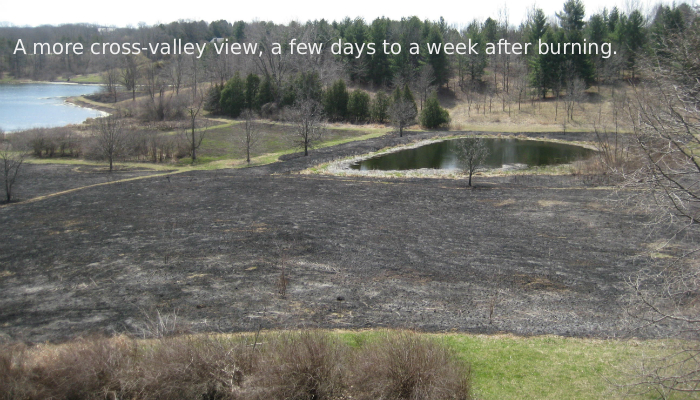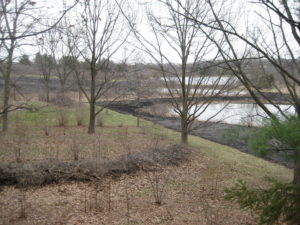Our Neighborhood Blackline/Blueline Firebreak

Both suburban and rural neighborhoods have their advantages and disadvantages for coping with wildfire. Suburban hydrants are close together with lots of water available. But individual homes can explode with flaming debris that spew ignition onto nearby houses – creating a chain reaction. Rural homes have better spacing, but a fire truck can only carry a few hundred to a few thousand gallons, and their access is often blocked by trees, gullies, and fences.

This down-valley view is a little deceptive. Due to the foreshortening angle, the emphasis becomes the ponds, whose berms/dams block the view of the burned prairie areas below them.
In the Gatlinburg, Tennessee wildfire of autumn 2016, both of these difficult scenarios played out, with loss of lives and homes. In our rural neighborhood in western Johnson County, we have taken a step to improve our situation. A valley runs down the middle and we have built a chain of ponds there. Around the ponds are mostly prairie plantings, which can be burned (done mostly at the first opportunity in late winter/early spring before the dangerous fire season gets underway).
Collectively, this gives us a blackline/blueline, which divides the neighborhood into mostly separate fire units and makes it less likely that a wildfire could cross over. An assortment of mown trails/firebreaks divide the grassland into smaller units where we can do controlled burns one at a time.
Once the prairie is burned, the driver of a small grassfire truck could see where he is going and would have better access to unburned areas (big fire trucks are too heavy and maneuverable for off-road).
In a worst-case disaster, our pre-burned valley is a nonflammable refuge. But this is not a cure all, and we still have good reason to also maintain fire safety in other ways. For example, see my Town and Country Tips on Fire Protection and details about spark arrestors.


